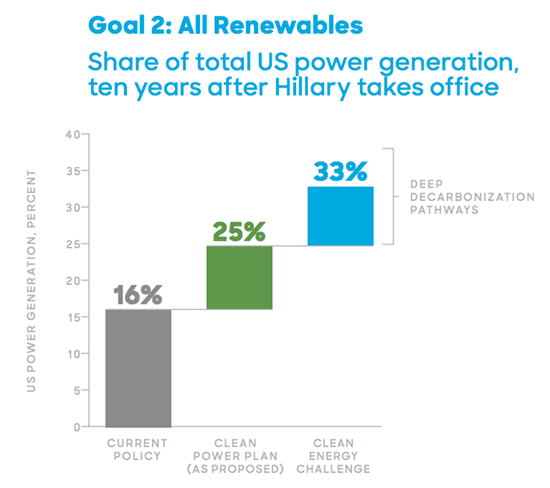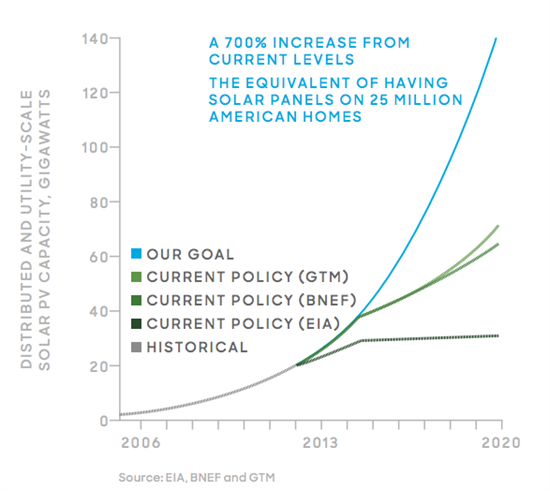
Hillary Clintons renewable goals could significantly raise US climate ambition
Simon Evans
07.28.15Simon Evans
28.07.2015 | 10:10amRenewable energy goals announced by Hillary Clinton, who hopes to succeed President Obama in 2017, could significantly raise US climate ambition.
Clinton wants renewables to supply a third of US electricity by 2027, enough to power “every home in America”. Carbon Brief analysis shows this could shave a further 4 percentage points off US emissions, against its existing pledge to cut carbon by 26-28% by 2025.
Clinton says she wants to make climate change a major campaign issue in the run-up to the 2016 presidential elections. Only two of 15 Republican candidates have acknowledged that climate change is real and must be tackled.
Carbon Brief explores what Clinton’s renewable energy goals could mean for the climate and why solar seems to be top of her agenda.
Renewable target
Current expectations for US renewables are based on Obama’s Clean Power Plan. Due to be finalised within weeks, the plan will set targets for power sector carbon intensity in each state and could encourage states to set or increase renewable portfolio standards that require generators to source a set share of electricity from renewables.
Under Obama’s plan, renewables are expected to generate a quarter of US electricity by 2030, up from 13% today. If the renewable share were to grow steadily in the years to 2030, it would be expected to reach just 23% by 2027.

Clinton’s renewable energy target compared to policy with and without Obama’s Clean Power Plan. Source: Clinton campaign factsheet.
So Clinton’s goal of 33% renewables by 2027 would represent a genuine increase in ambition. If nuclear plants continue to operate at current levels, then the US power mix would be roughly 50% zero carbon. This is the minimum for 2030 before billionaire climate activist Tom Steyer would give presidential hopefuls his backing and financial support.
Calculating the emissions impact of the 33% renewables target is not straightforward, however. US power plant emissions are expected to be around 1,700m tonnes (Mt) of CO2 in 2027, according to projections from the US Energy Information Administration.
If renewables met Clinton’s 2027 goal and took generation share exclusively from fossil fuels, emissions in that year could be reduced by up to 280Mt. This is equivalent to 4% of emissions in 2005, the US climate pledge baseline.
The current US pledge to the UN climate process promises a 26-28% reduction on this baseline by 2025.
There are a number of caveats to this calculation. Renewables might take electricity share from nuclear instead of fossil fuels. The expected shift in share of coal versus gas generation could be altered, with potentially large impacts on emissions.
Realistic goal
More substantively, some commentators are suggesting Clinton’s renewables targets may prove challenging to achieve.
As well as the 33% renewable electricity pledge, a second goal would aim for half a billion solar panels to be installed across the US by 2020. This would raise capacity from 20 gigawatts (GW) in 2014 to 140GW in 2020.

Clinton’s solar capacity goal against past and future trends under projections from Greentech Media Research (GTM), Bloomberg New Energy Finance (BNEF) and the Energy Information Administration (EIA). Source: Clinton campaign factsheet.
The target would be more ambitious than China’s plan to reach 100GW by 2020 and India’s aim to reach the same level by 2022. To reach 140GW by 2020, US solar expansion would have to accelerate rapidly.
The US Solar Energy Industries Association says capacity is expected to double to 40GW within the next two years, adding 8GW in 2015 and 12GW in 2016. But this growth would probably stall if federal tax investment credits end at the start of 2017 as planned.
Extending solar credits would need the support of Congress, however. Even if the tax credits are extended, installation rates would need to double to 25GW in each year between 2017 and 2020. While this sounds ambitious, it would be equivalent to the per capita rate of capacity increase during Germany’s solar push between 2008 and 2012.
At a campaign rally in Iowa Clinton said US tax incentives were weighed towards fossil fuels and needed to be fixed. Ending tax breaks for the oil and gas industry could finance the $60bn cost of her renewable goals, said a campaign spokesman quoted by Associated Press.
Just the beginning
Launching her climate plan in Iowa appears to be a significant move from Clinton. It is a key swing state and is socially conservative, with a relatively large Catholic population. However, a large majority of voters in the state back Pope Francis’s recent encyclical on climate change, according to a recent poll.
Clinton’s call to action on climate in advance of the 2016 presidential elections is clearly calculated to be a wedge issue for voters. In a video released alongside her renewable announcement, Clinton says: “It’s hard to believe that people running for president refuse to believe the settled science of climate change.”
In Iowa she said: “The reality of climate change is unforgiving no matter what the deniers say.” Fox News calls Clinton’s climate move a “gambit” with “considerable general election risk”. The New York Times says:
“Mrs. Clinton’s strategists see climate change as a winning issue for 2016…Polls show that a majority of voters support candidates who pledge policy action on the warming climate.”
Yet given Congressional gridlock and Republican attacks on climate policy, Clinton is pitching her climate and energy strategy carefully by using arguments around jobs, health and economic opportunity that are more likely to resonate with a broad cross-section of Americans.
A factsheet setting out Clinton’s renewable goals says they are designed to “combat climate change, create jobs, protect the health of American families…and make the United States the world’s clean energy superpower”.
Choosing solar as a flagship clean energy policy can also be no accident. It has growing bipartisan support, including within the libertarian Tea Party movement.
The factsheet says the two renewable goals are “just the beginning” for a comprehensive climate and energy agenda that Clinton will set out over the coming months.
It is telling that this includes doing more for coal communities that will lose out during the transition to a low-carbon economy. Clinton wants to “provide economic economic opportunities for those that kept the lights on and factories running for more than a century”.
Senators from coal states on both sides of Congress were behind the defeat of US cap and trade legislation. Although only four or five states retain significant coal mining industries, many others rely on coal for their power supplies.
Other elements yet to be elaborated include raising building energy efficiency, modernising transport systems, reducing oil use, transforming the electric grid and helping states or cities to accelerate their climate ambition.
For instance, California, among the most progressive states on climate, is discussing a 50% by 2030 target for renewable power which would exclude large hydro. This would take it far beyond where it needs to be to meet federal climate goals.
Alongside all of these new initiatives, Clinton promises to protect Obama’s Clean Power Plan if she is elected to the White House. Expected to be finalised within weeks, that plan is bound to face legal challenges from a number of states and businesses.
Even states challenging the rules are expected to begin working towards compliance, however. Otherwise federal authorities will prepare compliance plans for them, limiting states’ abilities to choose local solutions or approaches.
Main image: Hillary Clinton.
-
Renewable energy goals announced by Hillary Clinton could significantly raise US climate ambition

